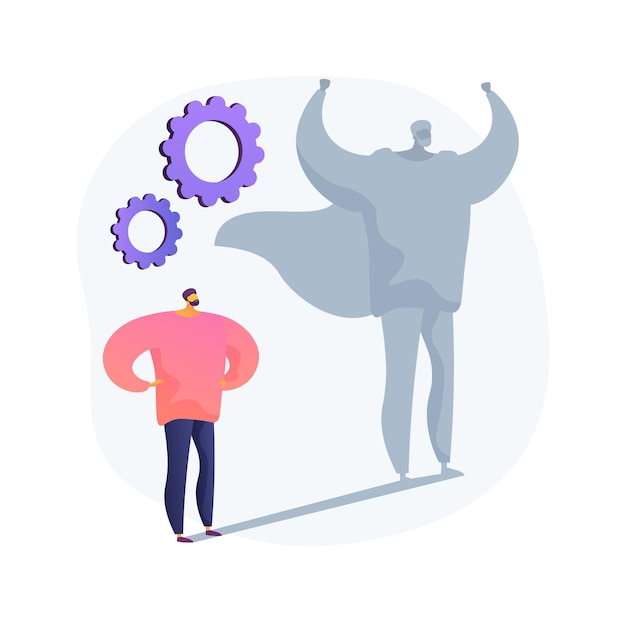The Art of Focusing on Your Strengths

Photo by upklyak @ freepik
In a world that often accentuates the need for all-round perfection, acknowledging one's strengths and weaknesses is pivotal. However, the journey to personal and professional excellence isn't about obsessing over what we lack but rather, cherishing and amplifying what we naturally excel at. The mantra for sustained growth and success lies in honing our strengths to such an extent that they become our trademarks, our personal brand of excellence.
The Power of Strengths Over Weaknesses
Understanding our strengths offers us a clear direction towards where our potential lies. It's akin to having a map of an unknown territory – it shows you where to go. Focusing on these areas not only boosts our confidence but also enhances our productivity and satisfaction levels. In contrast, an excessive fixation on weaknesses can lead to a decrease in confidence and a constant state of self-doubt, hindering growth.
Read more: Why It’s Important To Know Your Strengths And Weaknesses
Research in the realm of positive psychology suggests that individuals who utilise their strengths can improve their happiness and reduce depression. This doesn’t mean ignoring weaknesses but rather, understanding that the path to excellence is through the cultivation of our natural talents.
How to Sharpen Your Strengths
- Identify Your Strengths: Utilise assessments like CliftonStrengths, seek feedback from peers, or simply reflect on activities that make you feel energised and in flow. Knowing your strengths is the first step towards leveraging them.
CliftonStrengths employs ‘Talent x Investment = Strength’ formula. It is a straightforward yet profound insight into personal and professional development. It suggests that our innate abilities (Talents: The things we're inherently good at) can only become true strengths through deliberate effort. Investment: This can be through practice, training, and applying these abilities in real-life scenarios). Strength is the product of this equation—it's about how well we can harness and apply our talents in various situations. Strengths are talents refined and made reliable through effort and application.
- Set Strength-Based Goals: Create objectives that allow you to use and further develop your strengths. Whether it's leading a project at work that aligns with your strengths or picking up a new hobby that does the same, make sure your goals are aligned with what you do best.
- Find a Mentor or Coach: A mentor who recognises your strengths can guide you in focusing and developing them further. Their experience and insight can be invaluable in helping you navigate challenges while staying true to your core competencies.

- Practice Deliberately: Malcolm Gladwell's 10,000-hour rule underscores the power of focused, deliberate practice in achieving mastery. Allocate time to practice your strengths deliberately, challenging yourself to stretch those muscles in new and demanding ways. The essence of the 10,000-hour rule is not just about the quantity of time spent practicing but also the quality and purposefulness of that practice.
Key Components of the 10,000-Hour Rule:
- Deliberate Practice: This isn't just casual, repetitive action but a focused, structured, and intentional effort to improve one's skills. Deliberate practice involves pushing oneself beyond current capabilities, receiving immediate feedback, and continuously refining and reflecting on one's performance.
- Duration: The rule suggests that it takes approximately 10,000 hours of deliberate practice to achieve mastery in a field. This figure is not a precise threshold but rather an average estimate that underscores the significant time investment required to excel. This is also a nod at science behind CliftonStrengths as they formulated the Talent x Investment = Strength equation. It goes to show that if you invest on your talent it will become your strength.
- Early Start: Many of Gladwell's examples include individuals who began practicing their skill from a very young age, allowing them the time to accumulate hours and reach high levels of skill by adulthood.
- Innate Talent vs. Practice: While Gladwell acknowledges that innate talent can play a role in success, the 10,000-hour rule emphasises the transformative power of sustained effort and practice over natural ability alone.
However, there is a caveat when approaching this concept. Gladwell highlighted how practice isn’t a sufficient condition for success BUT the point is simply that natural ability requires a huge investment of time in order to be made manifest. Criticisms of the rule argue that it oversimplifies success, neglects the variability in individual talent and the number of hours needed for mastery, and underestimates the importance of other factors like socioeconomic background. Despite criticisms, the 10,000-hour rule highlights the value of persistence, dedicated practice, and a growth mindset in achieving expertise.
Gladwell also draws on research by psychologists and other experts who have studied the patterns of success and expertise development. One key figure in this research is Anders Ericsson, whose work on deliberate practice, forms the foundation of Gladwell's rule. We need to underscore the paramount importance of having a good teaching practice/teacher matters as this raise discipline and objectivity when developing your crafts.
- Seek Strengths-Enhancing Opportunities: Whether it's volunteering for projects that require your unique strengths or attending workshops that refine them, be on the lookout for opportunities to apply and grow your strengths.
To get the ball rolling, here are some inspiring icons:
Richard Branson, a visionary and risk-taker
Sir Richard Branson, founder of the Virgin Group, which controls more than 400 companies, has always played to his strengths of vision and an appetite for risk-taking. Branson, who struggles with dyslexia, never let his academic weaknesses define him. Instead, he focused on his strengths, starting a magazine at 16 and eventually building a business empire. His success story is a powerful reminder of how focusing on what you're good at can lead to extraordinary achievements.
Albert Einstein, challenging theoretical thought and exploring curiosity
Albert Einstein, whose name is synonymous with genius, was not always regarded as a promising student. He struggled with the rigid structures of early education, yet his strengths in theoretical thought and insatiable curiosity about the universe led him to develop the theory of relativity. Einstein's focus on his intellectual strengths, rather than his academic shortcomings, revolutionised our understanding of time, space, and gravity.
These individuals, each a giant in their respective fields, illustrate that success is NOT about being without weaknesses but about recognising, embracing, and focusing on your strengths. Their achievements underscore the power of this approach across a wide range of activities and challenges, offering inspiration and guidance for anyone looking to maximise their potential and impact the world positively.
Why You Shouldn't Dwell on the Negatives (aka your Weaknesses)
While it’s important to recognise and work on our weaknesses to a certain extent, dwelling on them can lead to a negative self-image and stall progress. Every individual has limitations, and it's often more productive to delegate tasks that fall outside our strengths zone to others who are more adept in those areas.
This section delves into how your less favourable traits, often hidden or unnoticed by yourself, can manifest. Carl Jung, a renowned psychologist, introduced the concept of a "shadow side" or "dark side" to our inherent traits, which many fail to recognise due to a lack of guidance. In the professional world, these are frequently referred to as ‘blind spots’—characteristics others can easily observe in us but of which we remain oblivious, potentially tarnishing our workplace image.

These shadow aspects tend to emerge when we either overextend, misuse, or suppress one of our innate abilities instead of nurturing it into a true strength. Interestingly, these aren't always areas of weakness; they are sometimes referred to as strengths in disguise.
For example, you might have received feedback in your career pointing to these blind spots, leading you to mistakenly believe they represent your shortcomings. It's common for individuals to neglect, minimise, or undervalue their talents, especially if they perceive those talents as not being appreciated within their team. The key lies in recognising these powerful inclinations within yourself and honing them, thus transforming potential vulnerabilities into your most significant assets.
Supplementary reading: Turn Your Strengths Into Superpowers
Focusing on your strengths does not mean ignoring your weaknesses entirely but understanding that the most significant growth and fulfilment come from what you do best. By redirecting energy from fixating on weaknesses to enhancing strengths, you create a positive feedback loop of success and confidence.
In Conclusion
The journey towards personal and professional greatness is paved with self-awareness, dedication, and a strengths-focused mindset. By identifying, honing, and strategically applying your strengths, you not only achieve excellence but also inspire those around you to discover and develop their own. So, as you move forward, remember the wisdom in playing to your strengths—it's not just about knowing what they are, but living them out loud. The journey from talent to strength isn’t always straightforward. It requires identifying the most effective ways to invest in one’s talents, which can vary greatly from one individual to another. Moreover, access to resources and support plays a significant role in this process.
Leaderonomics.com is an advertisement-free website. Your continuous support and trust in us allow us to curate, deliver and upkeep the maintenance of our website. When you support us, you enable millions to continue reading for free on our website. Will you give it today? Click here to support us.
Be sure to check out the media below:
Functional
Tags: Abundance Mindset, Alignment & Clarity, Brain Bulletin, Building Functional Competencies, Character, Competence, Emotional Intelligence, Engagement
Rabi'ah Mutalip is the Partnership Manager of Leaderonomics.com editorial work. She is an extroverted-introverted bookworm trying to find her place in this world. Connect with her via LinkedIn if you are interested in publishing your work on our website!





